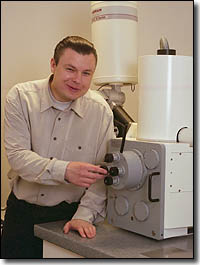Thinnest Wires Probe Superconductivity

Scientists at Harvard University have made wires too small to see without a powerful microscope. They are almost too small to imagine thousands of times thinner than a human hair and millionths of an inch long.
The immediate reason for doing this was to see if it could be done.
The long-term result may be computers much smaller and faster than the speediest supercomputers available today. Such supercomputers would be super cool, operating at about minus 458 degrees Fahrenheit. With these machines, military intelligence officers could crack the most complex codes, and five-day weather forecasts might even be right.
The supercomputers would be superconducting, that is, made out of wires and switches that allow electric currents to pass without resistance. Said another way, the electric currents that operate them would persist indefinitely without any voltage needed to drive them.
How small such machines can be depends on how small their wires can be made and still function as superconductors. Until now, no one knew the lower limits. But in todays (April 27) issue of the British scientific journal Nature, Harvard physicists provide the first answer: roughly 5 millionths of a millimeter across (5 nanometers), or about 200 thousandths of an inch.
“At present, this is purely a matter of scholarly interest,” notes Alexey Bezryadin, a postdoctoral fellow. “No generally accepted theory exists yet to predict how thin a wire can be and still be a superconductor.”
The experiments Bezryadin did with Chun Ning Lau, a teaching fellow, and Michael Tinkham, Rumford Professor of Physics, represent a start on building a basic understanding of the limits of superconduction.
No Width or Height
To make extraordinarily thin wires, the researchers rely on esoteric tubes of carbon known as nanotubes. Such structures are a mere 10-20 atoms across and a few thousandths of an inch long. Nanotubes, in fact, are so thin that researchers refer to them as one-dimensional; they allow no sideways or up-and-down motion of electric charge.
Bezryadin and his colleagues deposited a layer of metal, an alloy of molybdenum and germanium, on nanotubes, to produce wires of various thicknesses. They started off with wires about 400 thousandths of an inch (10 nanometers) wide, and made them thinner and thinner until they lost their superconductivity. This is the first step in discovering how different lengths of wire made of different materials will perform in any type of superconducting device.
Although supersmall superconducting supercomputers are an excellent example of the kind of devices that such basic research may make possible in the future, they are not the only example. Working out a theory to explain size limits for superconducting wires could have important applications for precise measuring devices, electric motors, and medical imaging equipment.
Parts of the theory of how thin wires conduct electricity without resistance apply to superfluidity, the movement of liquid without friction under certain conditions. (Two of the biggest discoveries in physics in the 20th century were superconductivity and superfluidity.) The latter could lead to practical applications not even thought of yet.
Superconductivity and superfluidity, however, dont give you something for nothing. Both wires and fluids must be cooled to extremely low temperatures, hundreds of degrees below freezing. That usually means keeping everything in an expensive bath of liquid helium.
Research is going on all over the world to find new materials that superconduct at much higher temperatures, as high as minus 300 degrees Fahrenheit or minus 120 degrees Celsius. Such temperatures can be maintained with relatively cheaper liquid nitrogen.
Theorists even believe it may be possible to achieve superconductivity at room temperature. If so, Bezryadin and his colleagues hope to be able to determine how thin the wires in such devices can be.




